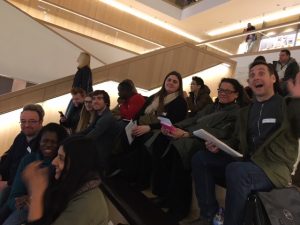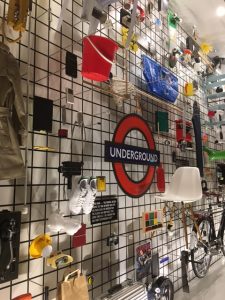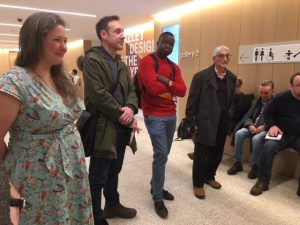We did a little experiment. What if we organise a visit to the Design Museum (on a grey and rainy February weekend) and everyone from the Design and Innovation Qualification at the OU is invited to come. Who would come and join us?

Twenty-five students, 2 tutors and 4 central academics from across the qualification came, and we had a fabulous day!
First we went to see ‘Designer Maker User’, the museum’s permanent exhibition. The exhibition shows that design is a result of a relationship between three groups – the designers, the users, and the manufacturers or makers. The exhibition has three major areas, each focusing on one group. On display are a variety of objects, from construction materials to fashion. We were tasked to look for three objects that most interest us.
 The choices of designs that were discussed was as large as our group. For example, the AK-47 machine gun was hotly debated. Is this really an example of ‘good design’? Although it is a perfect example of sustainable design (easy to use, durable, widely copied), its fallible ethics render it not such a good design after all. We agreed that we have come a long way in terms of production processes, methods and materials, but making something easier to use, easier to produce or to sell is not the sole attribute of goodness.
The choices of designs that were discussed was as large as our group. For example, the AK-47 machine gun was hotly debated. Is this really an example of ‘good design’? Although it is a perfect example of sustainable design (easy to use, durable, widely copied), its fallible ethics render it not such a good design after all. We agreed that we have come a long way in terms of production processes, methods and materials, but making something easier to use, easier to produce or to sell is not the sole attribute of goodness.
The Beazley Designs of the Year were explored in the afternoon. We were impressed by the the strong, value-laden examples of design. Many were ‘quiet designs’, such as the refugee text system, the protest banner making workshop, or the Warka Water tower. Overlapping themes emerged, such as reusing and repurposing, community design and empowerment, designing for inclusion and awareness. The exhibition curators emphasised how difficult it is to show some of the quiet designs in an exhibition, because the real impact is not visual, but lies in the story the designs tell and values they propagate. And again, the discussion returned to ‘good designs’ and we agreed with the curators that sometimes you can get it wrong, you cannot tell what a truly good design is when you first see it. Time tells.

Only time will tell if our experiment will add value to the design and innovation qualification offer at the OU. My questions to the students was: What is a good face-to-face learning experience in a distance design learning context? The museum visit was definitely well received and one student commented that if something like this would have been on offer a few years ago, it would have made her pathway choices easier and it would have been clearer to see where she is progressing to.
So come join us in one of our next experiments. We organise a Design Fair in Milton Keynes on the 10th of March, and a Design workshop at the Imperial War Museum in Manchester on the 17th of March.

Leave a Reply